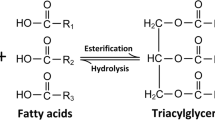Abstract
Biodiesel from waste cooking oil (WCO) and soybean oil (SO) mixture was produced by changing the alkali catalyst (NaOH) content and the WCO to SO ratio in the feedstock. All the prepared biodiesel samples satisfied the standard requirement in terms of free glycerol, density, and acid value. The minimum catalyst content and the highest WCO composition to get biodiesel from the WCO/SO mixture feedstock without ruining the biodiesel properties were 1.0 and 60 wt %, respectively. This conclusion implies that the waste cooking oil mixture, which contains 40 wt % fresh soybean oil, could be treated like the fresh soybean oil to produce biodiesel, and that this behavior would be helpful to reduce the biodiesel production cost when waste cooking oil used as feedstock. The unsaturated methyl esters such as linoleic, and oleic acid were dominant (almost 80 % w/w) in the fresh soybean oil. However the saturated methyl ester was increased due to the double bond breaking during the frying process. These results may deteriorate the biodiesel quality by changing the methyl ester composition.






Similar content being viewed by others
References
Dermibas A (2005) Biodiesel production from vegetable oils via catalytic and non-catalytic supercritical methanol transesterification methods. Prog Energy Combust Sci 31:466–487
Kouzu M, Kasuno T, Tajika M, Sugimoto Y, Yamanaka S, Hidaka J (2008) Calcium oxide as a solid base catalyst for transesterification of soybean oil and its application to biodiesel production. Fuel 87:2798–2806
Lu H, Liu Y, Zhou H, Yang Y, Chen M, Liang B (2009) Production of biodiesel from Jatropha curcas L.oil. Comput Chem Eng 33:1091–1096
Sharma YC, Singh B, Upadhyay SN (2008) Advancements in development and characterization of biodiesel: a review. Fuel 87:2355–2373
Bajpai D, Tyagi VK (2006) Biodiesel: source, production, composition, properties and its benefits. J Oleo Sci 10:487–502
Issariyakul T, Kulkarni MG, Meher LC, Dalai AK, Bakhshi NN (2008) Biodiesel production from mixtures of canola oil and used cooking oil. Chem Eng J 140:77–85
EN 14103 (2003) Fat and oil derivatives. Fatty acid methyl esters (FAME). Determination of ester and linolenic acid methyl ester contents
Nakpong P, Wootthikanokkhan S (2009) Biodiesel production from mixtures of vegetable oil and used cooking oil. As J Energy Env 10(04):221–229
Felizardo P, Correia MJN, Raposo I, Mendes JF, Berkeimer R, Bordado JM (2006) Production of biodiesel from waste frying oils. Waste Manage (Oxford) 26:487–494
Leung DYC, Guo Y (2006) Transesterification of neat and used frying oil: optimization for biodiesel production. Fuel Process Technol 87:883–890
Phan AN, Phan TM (2008) Biodiesel production from waste cooking oils. Fuel 87:3490–3496
Ryan TW, Dodge G, Callahan TJ (1984) The effects of vegetable oil properties on injection and combustion in two different diesel engines. J Am Oil Chem Soc 61(10):1610–1619
Knothe G (2005) Dependence of biodiesel fuel properties on the structure of fatty acid alkyl esters. Fuel Process Technol 86:1059–1070
Allen CAW, Watts KC, Ackman RG, Pegg MJ (1999) Predicting the viscosity of biodiesel fuels from their fatty acid ester composition. Fuel 78:1319–1326
Alcantara R, Amores J, Canoira L, Fidalgo E, Franco MJ, Navarro A (2000) Catalytic production of biodiesel from soy-bean oil, used frying oil and tallow. Biomass Bioenergy 18:515–527
Gerpen JV (2005) Biodiesel processing and production. Fuel Process Technol 86:1097–1107
Author information
Authors and Affiliations
Corresponding author
Rights and permissions
About this article
Cite this article
Primata, M., Seo, Y.C. & Chu, Y.H. Effect of alkali catalyst on biodiesel production in South Korea from mixtures of fresh soybean oil and waste cooking oil. J Mater Cycles Waste Manag 15, 223–228 (2013). https://doi.org/10.1007/s10163-012-0111-8
Received:
Accepted:
Published:
Issue Date:
DOI: https://doi.org/10.1007/s10163-012-0111-8




